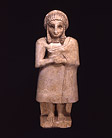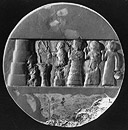Gender and Social Status
Textual sources show us that although women were able to own and inherit property and hold certain kinds of jobs, even at times attaining an elite status, Mesopotamian society was for the most part male-dominated. The social status of men depended on their profession; scribes were considered to be elites, officials in the temple and palace were in the top level of society with the king, naturally, at the top. The status of a woman, on the other hand, was usually determined by that of her husband, or, before marriage, by that of her father. In this way, even though a priestess might have held high status because of her profession, it was the male god to whom she belonged (or to whom she was “married”) who bestowed this high status upon her.
While gender roles were clearly defined, there were occasions when distinctions between the genders were blurred. Textual sources speak of a festival for the goddess Inana in which men become women and women become men. Inana herself had a female and a male side and transvestites or transgendered people were among her entourage. Scholars have suggested that the existence of such a deity and such occasions may have served as a release from the otherwise strict gender distinctions that were the norm.

 Jennie Myers
Jennie Myers
Research Associate, University of Chicago
Guiding Questions
1. How did ancient Mesopotamian cultures reflect the concept of “assimilation”?
2. How did geographic factors, particularly mountains and bodies of water, factor into the blending, or, in some cases, the lack thereof, of cultures in ancient Mesopotamia?
3. How does the polytheism of ancient Mesopotamia reflect political, social, and economic systems based on family ties?


 Print Page
Print Page


